Baby, also called infant, is a child up to about 18 months of age. Almost everyone loves babies. They are among the most talked-about and most photographed subjects in the world. Poets have praised them, and painters have pictured them as models of innocence. But throughout most of history, people had to accept the fact that many babies would die of disease or hunger before they were 1 year old.

Since the late 1800’s, advances in medicine, public health, and food production have sharply reduced the number of infant deaths in many parts of the world. The greatest progress has been in the industrial countries, especially Australia, Canada, Japan, New Zealand, the United States, and most Western European nations. Today, less than 1 percent of the babies born in these countries die before the age of 1 year. Progress has been much slower in the nonindustrial countries of Africa, Asia, and Latin America. In some African and Asian countries, more than 20 percent of all babies die before they are 1 year old.
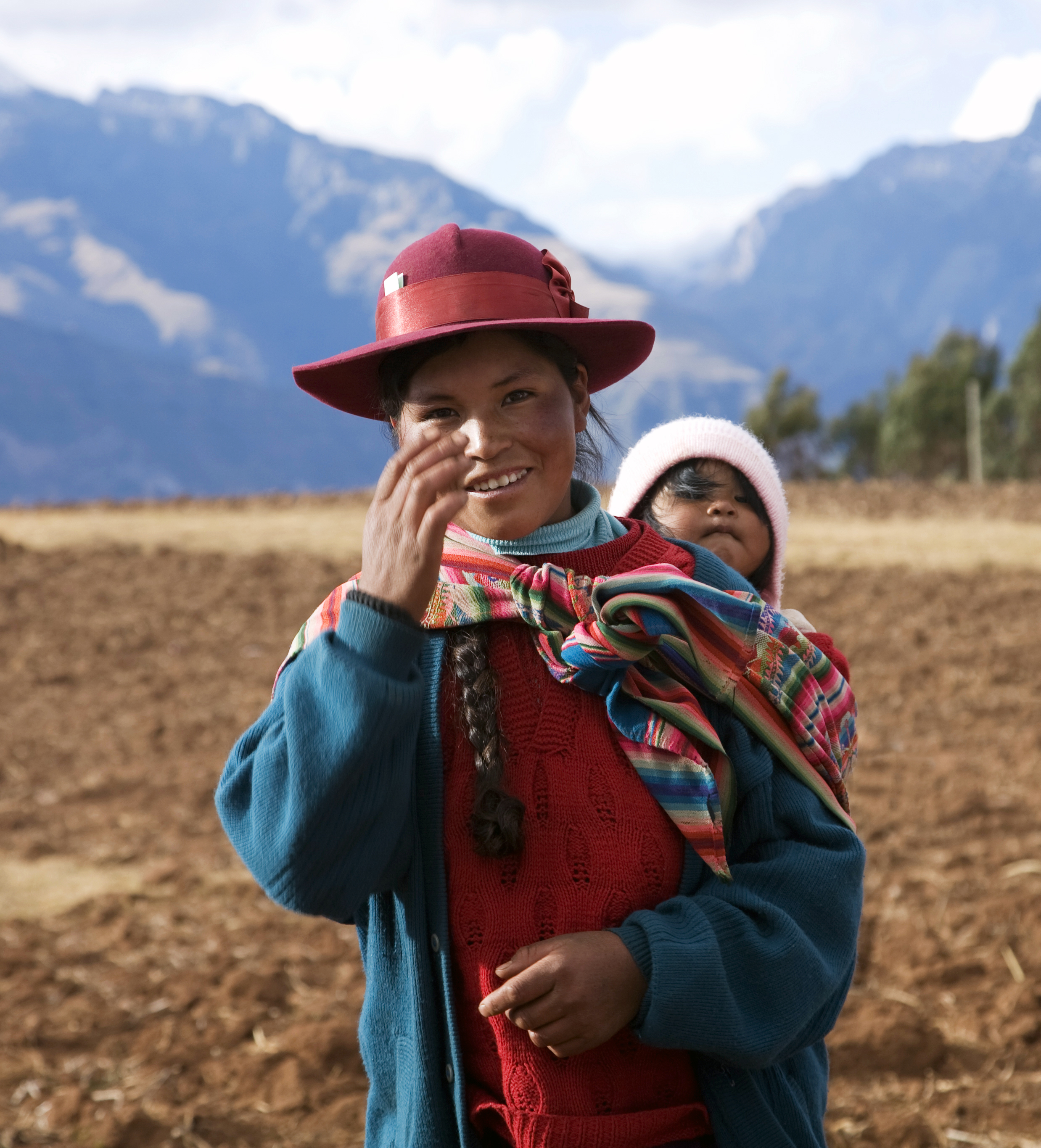
Newborn babies are completely helpless. They cannot sit up, move from one place to another, feed themselves, or talk. Crying is their only means of telling people when they are hungry, unhappy, or hurt. With good care, babies gradually learn to do certain things for themselves. By the time they are about 18 months of age, most children can walk and run without help, feed themselves, play simple games, and say a few words and phrases. They are then no longer considered to be infants.
This article traces the development and growth of babies from before birth through infancy. It also discusses baby care. For more information on the growth and development of babies and of older children, see the articles Child; Growth. For information about the young of various kinds of animals, see Animal (How animals raise their young).
Before birth
For a baby to develop, a sperm (sex cell from the father) must unite with an egg (sex cell from the mother). This union of a sperm and an egg is called fertilization. It produces a single cell called a fertilized egg. By a series of remarkable changes, the fertilized egg gradually develops into a baby.
A baby develops in the uterus, or womb—a hollow, muscular organ in the mother’s abdomen. The period of development in the uterus lasts about nine months in most cases. During this period, development is more rapid than at any time after birth.
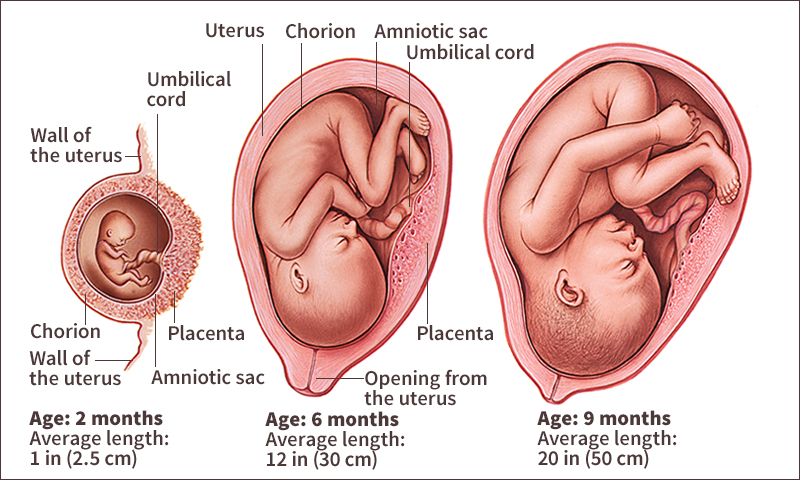
A fertilized egg is smaller than a grain of sand. Yet it contains a complete “blueprint” for the growth and development of a new individual. The blueprint consists of 46 tiny structures called chromosomes. Half of them come from the mother’s egg, and half come from the father’s sperm. Together, the chromosomes carry all the characteristics that babies inherit from their parents. These characteristics include general body build, eye and hair color, and other physical traits as well as mental ability. To learn more about how we inherit various characteristics, see Heredity.
The developing baby.
A baby goes through two major stages of development before birth. During the first stage, which lasts about two months, a developing baby is called an embryo. During the second stage, which lasts about seven months or until birth, it is called a fetus. Growth takes place during both of these stages by cell division.
The first cell division in a baby’s development occurs when the fertilized egg divides in two. This division happens almost immediately after fertilization. Before the cell divides, the chromosomes duplicate themselves. The resulting two cells thus have an identical set of 46 chromosomes each. These two cells then grow and divide, producing four cells with identical sets of chromosomes. The cells grow and divide over and over again, with each cell producing an exact duplicate of itself. The cells form an irregularly shaped, hollow ball, which becomes attached to the lining of the uterus. This tiny mass of multiplying cells forms the beginning of the embryo. A thin layer of tissue called the amniotic sac surrounds the developing embryo.
About a week after the first cell division, the cells that make up the embryo start to specialize. Groups of cells thus begin to form different organs, such as the brain and heart. The connection with the uterus develops into the placenta, an organ composed largely of blood vessels. The placenta is attached to the wall of the uterus. A tubelike structure called the umbilical cord joins the placenta to the embryo at the abdomen.
The placenta supplies everything that the embryo needs to live and grow. The placenta absorbs nourishment and oxygen from the mother’s blood and transmits them to the embryo through the umbilical cord. Carbon dioxide and other waste products from the embryo travel through the umbilical cord to the placenta, which releases them into the mother’s bloodstream. The placenta performs these functions until the baby is born.
By the end of the second month, the embryo measures about 1 inch (2.5 centimeters) long and weighs about 1/2 ounce (14 grams). Although it is small and undeveloped, it has all the basic organs and features of a human being. The developing baby is now called a fetus.
After the second month, the organs gradually mature, and the fetus shows the first signs of movement. Meanwhile, the amniotic sac has filled with a salty fluid. The fetus floats freely in this fluid, limited only by the umbilical cord. The fetus can twist and turn in every direction and even make somersaults in the amniotic sac. The mother may begin to feel these movements during the fifth month of pregnancy.
By the end of the ninth month, the fetus is well developed and ready to be born. Some infants are born prematurely—that is, before the ninth month. Premature babies born after the seventh month of pregnancy have a good chance of surviving and developing normally if they receive special medical care. Babies born as early as the sixth month of pregnancy may also survive, but complications are common.
The expectant mother.
An expectant mother should receive medical care and lead a healthy lifestyle to protect the health of her baby. The first weeks of pregnancy, when the embryo begins to develop, are especially important. For this reason, a woman should have a physical examination as soon as she learns she is pregnant. In addition, she should arrange for regular physical checkups throughout her pregnancy. The examination and checkups help a doctor prescribe the kind of prenatal care that an expectant mother should receive.
Most women require more food, especially foods high in proteins, after they become pregnant. But weight gain should be gradual. A sudden gain may indicate a physical disorder. Meals should provide the same nourishment as any well-balanced diet (see Nutrition ). In addition, doctors often prescribe extra amounts of certain vitamins and minerals for expectant mothers. Weight-losing diets should be avoided except under a doctor’s orders. Any chemical in an expectant mother’s bloodstream enters the developing baby’s bloodstream through the placenta. For this reason, women should not smoke or take unnecessary drugs while they are pregnant.
A woman should continue her normal activities, including proper exercise, during pregnancy. She should also get enough sleep and rest. For more information on this subject, see Pregnancy.
Birth
The birth process is called labor. A woman is ready to give birth when she feels labor pains as the muscles of the uterus begin to contract. The alternate tightening and relaxation of the muscles enlarges the opening from the uterus to the birth canal, or vagina. As the muscle activity continues, it forces the baby out of the uterus and through the birth canal. Most babies are born head first. The head is bigger around than the rest of the body and so enlarges the opening that leads outside the mother’s body. The rest of the baby’s body thus passes through the opening easily.
Within a few minutes after birth, a baby starts to cry heartily, which helps the lungs expand and fill with air. The umbilical cord is still attached to the placenta after a baby is born. The doctor clamps and cuts the cord close to the baby’s skin. This tiny stump of tissue dries up and falls off within 7 to 10 days, leaving a scar, called the navel, on the abdomen.
The muscles of the uterus continue their activity until the placenta separates from the uterus and passes out the birth canal. The discharged placenta is called the afterbirth. For additional information, see Childbirth; Reproduction, Human.
Growth and development
Two major forces—heredity and environment—influence a baby’s growth and development. Heredity determines the characteristics that babies inherit from their parents through the chromosomes. Environment consists of everything with which a baby comes in contact, including the kind of care the baby receives. Environment especially affects the formation of a baby’s personality.
A baby’s personality begins to develop soon after birth. The development continues throughout childhood and even throughout life. But most experts believe that a person’s very early experiences have an especially strong influence on later personality development. For example, infants who never have their needs met when they cry may eventually lie in bed quietly, causing little disturbance. But in time, their emotional, mental, and social growth will fall behind that of other children. Babies who are cared for lovingly—that is, in close and understanding contact with the people who care for them—have the best chances of developing a normal, healthy personality.
Babies differ in the rate and manner of their growth and development. For example, many infants begin to crawl at about 9 to 10 months of age. But some begin to crawl earlier and others later. Still other babies learn to walk without ever crawling.
The first month.
A baby is considered a newborn for about a month after birth. Newborn babies spend most of their time sleeping.
Characteristics of newborn babies.
The average weight for a baby at birth is 71/2 pounds (3.4 kilograms). The average length of a newborn is 20 inches (50 centimeters). A newborn baby’s head makes up about a fourth of the total body length and is bigger around than the chest. The arms are longer than the legs. These proportions change as a child becomes an adult. The head, for example, grows less than the rest of the body and makes up about an eighth of an adult’s height.
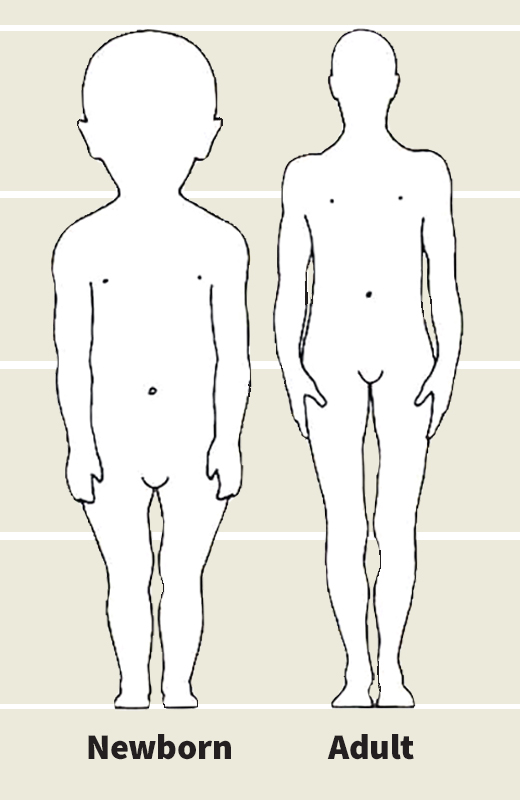
A newborn baby’s skull has six soft spots where the bone is not yet completely joined. These areas become completely covered with bone by about the 18th month. The other bones in a baby’s body are only partly calcified (hardened with calcium) at birth. These bones calcify gradually throughout childhood.
Most white children have grayish-blue eyes and pink skin at birth. The color of the eyes may change by the fifth or sixth month. This color then becomes permanent. Most black children have brown eyes and relatively light, pinkish skin at birth. The eyes remain brown. The skin begins to darken a few days after birth.
Most of a newborn baby’s actions are reflex actions—that is, they are completely automatic. Newborn infants can suck and swallow, move their arms and legs, and cry to make their needs known. When lying in bed, they often curl up in a position like the one they had in the womb. If startled by a loud noise or sudden jolt, they jerk their arms and legs in a reflex action called the startle reflex. For several months, the baby’s neck muscles will not be strong enough to hold the head erect. A person must therefore be careful to support the head while picking up or holding the baby.
Newborn babies cannot control the movements of their eyes. But they can tell darkness from light and see objects directly in front of them. Newborn babies can also hear, and they quickly learn to recognize their mother’s voice.
Feeding and rate of growth.
Newborn babies can swallow only liquids. They therefore get their nourishment by sucking milk from their mother’s breast or from a bottle. Mothers may begin to nurse their babies—that is, feed them milk at the breast—within a few minutes after birth. In most cases, the breasts do not produce a full supply of milk until several days after birth. But babies need little nourishment during this time. Babies who are not breast-fed are given a special formula that usually is made from cow’s milk. This formula resembles mother’s milk and is fed from a bottle with a rubber nipple.
Newborn babies can digest less than 2 ounces (60 milliliters) of mother’s milk or formula at a time. As a result, they must be fed often—in most cases, about every four hours day and night. Babies lose weight for a few days after birth because their food intake does not yet meet their needs. But most babies regain the lost weight by about the 10th day after birth. They then begin to gain about 1 ounce (28 grams) a day.
From 1 to 6 months.
A baby’s growth rate slows after the third month. By the seventh month, the rate will have dropped to about 1/2 ounce (14 grams) a day. At 5 months, most babies weigh about twice what they weighed at birth.
By the second month, babies have begun to develop various motor skills. Motor skills are controlled movements rather than reflex actions. They depend largely on the development of the brain and nerves.
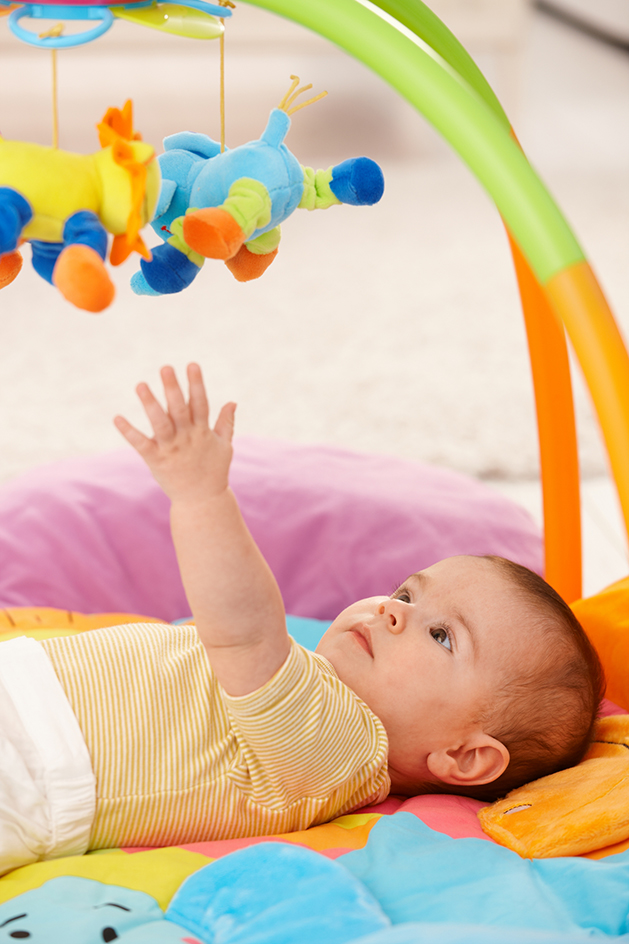
The development of motor skills begins with the head and progresses downward through other parts of the body. Thus, babies learn to move their head and eyes before they can control their arms and legs. By the second month, most infants can turn their head and eyes to follow the movements of people and large objects. By the age of 5 or 6 months, most babies can hold their head erect, grasp objects with their hands, turn themselves over in bed, and sit erect if propped up against something.
Babies first smile and make speechlike sounds at 2 to 3 months of age. To develop normal human relationships, children need a feeling of trust and security. Parents help develop such a feeling in a baby if they treat the baby with love and understanding. Yet parents should avoid being overprotective and not give in to a baby’s every demand. Children can thus develop a frustration tolerance—that is, the ability to control their feelings when some of their demands are not met.
From 6 to 12 months.
Babies achieve a number of “firsts” between 6 and 12 months of age. The first tooth usually appears about the sixth or seventh month. The teeth then continue to grow out at the rate of about one a month until a child has a complete set of 20 primary, or baby, teeth. Most children have all their primary teeth by about 21/2 years of age (see Teeth (Kinds of teeth) ). After they are about 6 months old, babies learn to pick up small objects and pieces of food by clasping them between the thumb and palm. Most babies sit unsupported for the first time by about 7 months. By about 9 months, they may pull themselves to their feet and stand with support.
At about 6 months of age, most babies develop a degree of independence. Their personality then begins to show itself in various ways. For example, they may want to hold their bottle instead of having it held for them. Gradually, every baby develops characteristic ways of doing things, which differ from the ways other babies do the same things. Such differences in behavior indicate the growth of individuality.

From 12 to 18 months.
Babies learn how to do many things by imitating older people. Their ability to imitate improves after they have reached 12 months of age, probably because of a sudden advance in brain and nerve development.
Most infants start to walk with support about the 12th to 13th month. They take their first unaided steps by about 15 months and can run by 18 months. Babies also start to play with blocks, balls, and other objects about the 12th month. At first, they may simply throw the objects or put them in their mouth. But by the 18th month, many infants have learned, for example, to pile a few blocks on top of one another and to push objects along the floor with their hands.
Most babies can say a few words in addition to “Mama” and “Dada” by the age of 12 months. At 15 months, they may “talk” energetically. But they still know few real words. At 18 months, a child’s vocabulary may consist of about 10 to 20 words. Many children can also combine words into phrases at this age.
Babies understand many more words than they use. By 8 or 9 months, most babies respond to the sound of their name. A 1-year-old recognizes the names of a variety of objects and understands “no” and certain other commands. By the age of 15 to 18 months, most babies enjoy listening to simple songs and nursery rhymes. They may also enjoy hearing a story, though the story itself probably means little to them. Most babies this age like to watch television and look at pictures in books and magazines.
Sometime after 18 months of age, a child may be ready for toilet training—that is, learning to control the bowels and bladder. But the age when such control becomes possible varies greatly among children. Parents should not force toilet training but wait until a child shows readiness for it.
Baby care
Providing the proper environment.
A baby’s surroundings should be clean, safe, and cheerful. Room temperatures should be carefully regulated so that a room is neither too warm nor too cool. In addition, babies old enough to move about need room to play. But beyond these simple requirements, physical surroundings alone have little influence on an infant’s development. The people responsible for a baby’s care—and the attention and stimulation that these people provide—are by far the most important part of the baby’s environment.
Babies require much love and affection. They need to be held and soothed when they are disturbed or hurt, and they need to be treated at all times with respect and understanding. Parents help their baby develop a sense of trust and security if they respond to the baby’s needs faithfully and confidently. On the other hand, parents who are anxious or nervous may communicate these feelings to a child.
Love also includes discipline—the setting of certain limits on behavior. Children grow up with fewer personal problems if they learn at an early age that some types of behavior are not permitted. Discipline should be firm but just. Harsh discipline may do as much harm to a baby’s development as no discipline at all. A child should never be beaten or shaken.
Feeding procedures.
The mother’s breast milk is the best food for babies during the first few months after birth. But a milk-derived formula is an acceptable substitute. Babies usually stop feeding when they have had enough. If they take too much milk at a feeding, they will probably spit part of it up. They may also spit up part of a feeding if gas bubbles form in the stomach. To help release the bubbles, the baby should be held upright against the shoulder. The baby’s back should be patted firmly, in a practice called burping.
Breast-feeding
is the natural method of providing milk for a baby. In some countries, it is also the most common method. Mother’s milk contains all the nourishment that most babies need. Mother’s milk also contains substances that help protect the baby from various diseases and infections. A doctor may prescribe added amounts of certain vitamins and minerals for a breast-fed older infant to ensure an adequate supply.
Bottle-feeding.
Homemade or commercially prepared formulas can be substituted for mother’s milk. Both types are usually made from pasteurized cow’s milk. But cow’s milk differs from mother’s milk in several ways. For example, it has more protein and less sugar than mother’s milk. In preparing the formula, sugar and water are therefore added to cow’s milk to make it as much like mother’s milk as possible.
Most commercial formulas come ready to use in liquid form. Some commercial formulas come in powdered form. A person simply adds water. But formulas prepared in this way, as well as the bottles and nipples, must be sterilized by boiling. Special soybean formulas are available for babies who have an allergy to milk.
Vitamins and iron.
Unlike mother’s milk, cow’s milk lacks vitamin C. Bottle-fed babies must therefore have vitamin C added to their diet. Mother’s milk and cow’s milk contain vitamins A and D. But doctors often prescribe extra amounts of these vitamins for both breast-fed and bottle-fed infants to ensure an adequate supply. Doctors may also prescribe added iron in an infant’s diet after the first three or four months.
Vitamins are given to a baby in the form of drops or as part of the formula. Many commercially prepared formulas are vitamin enriched. Iron may be given in the form of drops. But it is also present in iron-fortified cereals and in some of the other solid foods a baby may be fed after about the second month.
Solid foods.
After 2 to 3 months of age, most babies begin to make chewing motions and improve their ability to swallow. However, they should still consume mother’s milk or formula at this time. After 6 months, they can then be fed solid foods. But the food must be soft and mushy at first so that the baby can chew and swallow it easily. Such foods include cooked cereals and various fruits and vegetables that have been pureed. Pureed foods are cooked until soft and then processed in an electric blender or pushed through a strainer or sieve. Such foods may be prepared at home or bought already prepared.
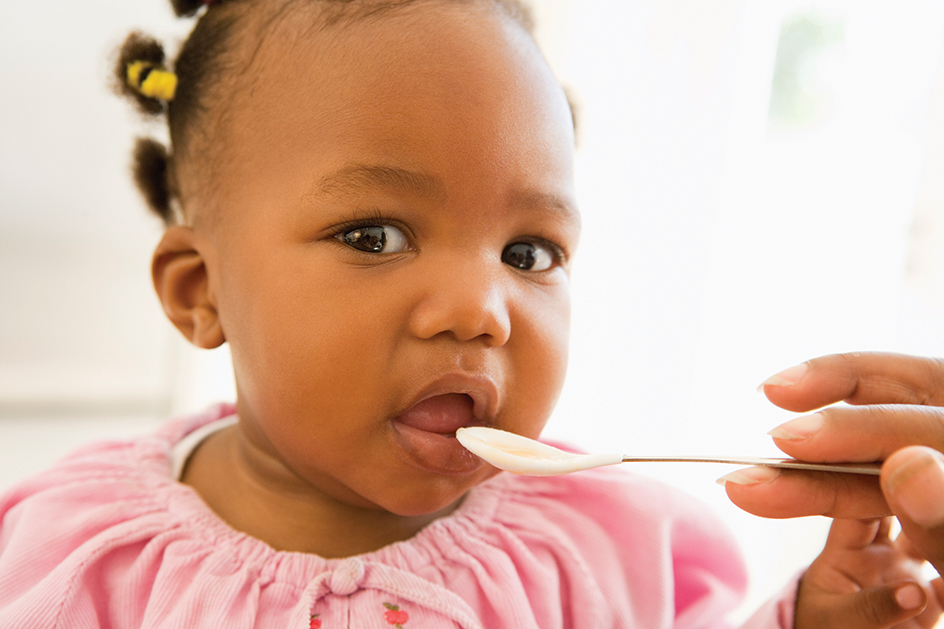
After the age of 6 months, most infants will begin to enjoy foods that require more chewing. Although babies have few or no teeth at this age, they can chew with their gums. Many parents add such foods as crackers and pureed meats to the baby’s diet at this time. After about 9 months of age, a baby can begin to eat most of the same foods that other family members eat. But the food must be mashed or cut in very small pieces so that the baby will not choke on the food. By the age of 18 months, most babies can feed themselves with a spoon.
Feeding schedules.
Most babies require five or six feedings a day until they are about 3 months old. They can then go on four feedings daily. After they are 5 or 6 months old, most babies can go on a schedule of three meals a day with between-meal snacks. But infants differ greatly in how often they need to be fed. Instead of following a strict feeding schedule, many mothers arrange the feedings according to the times when the baby shows signs of being hungry. An infant ordinarily becomes hungry at about the same times every day. Babies may thus establish their own feeding schedule.
Weaning.
At about 6 months of age, a baby may be ready for weaning—that is, learning to do without milk from the breast or bottle. Babies differ in their readiness for weaning. Some children do not show a willingness to give up breast- or bottle-feeding until they are 18 months of age or older. A mother should wean her child over a period of several weeks or months. In preparation for weaning, she may encourage the baby to drink milk from a cup. Most babies can learn to drink from a cup by the time they are 6 or 7 months old.
Sleeping conditions.
Babies sleep up to 23 hours a day during the first month after birth. Their need for sleep then gradually decreases.
For safety and comfort, a baby should sleep in a specially designed crib. Most cribs have barred sides that can be lowered and raised by an adult. Babies should be kept covered in their crib to avoid chills. Most infants like to lie on their stomach or back with their head turned toward the lightest part of the room.
By about 3 months of age, most infants begin to have a restless, wakeful period each day. They may then squirm and cry a little for exercise. It may help at such times to put the baby in a playpen near other members of the family. After a short play period, the baby may be fed, changed, and put back in bed. Parents should not be disturbed if a baby cries for a short while before falling asleep again.
By the age of 18 months, most babies need about 14 hours of sleep daily, including an afternoon nap. Some babies need less sleep than others do and may lie awake for a while during their normal time for sleeping.
Crying
usually means that a baby feels hungry, needs a diaper change, or is uncomfortable, tired, or neglected. Babies ordinarily stop crying when the condition is corrected. Feeding, diaper changing, or cuddling is all that an infant needs in most cases. Parents should consult a physician if they cannot find the cause of an infant’s crying within a reasonable length of time.
Bathing the baby.
Most doctors recommend that a baby not have a tub bath until the stump of the umbilical cord has dried up and fallen off. This process usually takes from 7 to 10 days. Meanwhile, the baby can be given a daily sponge bath with a warm damp cloth.
Babies may have their first tub bath after the navel has healed. For about the first year after birth, they should be bathed in a small tub or basin rather than in a full-sized bathtub. It is much easier to manage babies this age in a small tub than in a large one. They especially need help in keeping their head above water. By about 12 months of age, most infants can control their posture well enough to be bathed in a regular bathtub. Babies should never be left unattended in their bath at any age.
A baby’s bathwater should be comfortably warm, not hot. Mild soaps are best for an infant’s skin and may be used for washing the scalp as well as the rest of the body. Many parents soap the baby outside the tub and use the tub water for rinsing. The face should be washed without soap to avoid irritation to the eyes.
Babies may be bathed every day or every other day. They need fewer baths during winter than during summer. Washing the diaper area with a warm damp cloth at every diaper change helps prevent rashes.
Clothing the baby.
Babies must be dressed warmly enough to avoid chills. But even in cold weather, they need only a few simple kinds of clothing. Many babies are sensitive to wool. They should wear clothes made of cotton or synthetic materials.
Most children have to wear diapers from birth well past the age of 18 months. Some parents use cloth diapers, which must be washed after every use. If parents prefer not to wash diapers themselves, they may subscribe to a commercial diaper service. Such services both supply and launder the diapers. Other parents use disposable diapers, which are thrown away after use. Most disposable diapers are made of absorbent paper lined on the outside with a layer of plastic.
Indoors, a baby needs little more than a diaper and a shirt. If it is cool indoors, the shirt may be replaced with a nightgown or light coverall suit. Newborn infants are often wrapped in a cotton blanket for warmth.
Most babies enjoy being outdoors for a while during the day. An infant’s skin burns easily and so should not be exposed to direct sunlight for more than a few minutes. For outdoor wear in cold weather, babies need a cap and such other extra clothing as a sweater and warm coverall suit.
Health care and safety.
In many countries, including the United States and Canada, a mysterious disease called sudden infant death syndrome (SIDS) ranks as the chief cause of death among infants from 1 to 12 months of age. The disease resembles suffocation. The victims, seemingly healthy children, die suddenly in bed. Scientists are working to find the cause of sudden infant death syndrome.
Less than 100 years ago, diphtheria, measles, and certain other infectious diseases killed many thousands of infants yearly. But since the early 1900’s, scientists have developed vaccines that have greatly reduced the number of infant deaths from these diseases.
The United States Centers for Disease Control and Prevention recommends that all babies be vaccinated against 11 diseases—chickenpox, diphtheria, measles, mumps, polio, rotavirus, rubella, tetanus, whooping cough, meningitis caused by the bacterium Haemophilus influenzae type b, and hepatitis B. The article Immunization includes a recommended schedule for receiving these vaccinations.
Accidents in the home cause many injuries and deaths among babies each year. Parents can do much to prevent such accidents. For example, they can help prevent serious burns by keeping babies away from flames and hot stoves. To avoid accidental poisoning, parents should keep medicines, household cleaners, and other chemicals in a cabinet out of a child’s reach. Parents should never leave a baby at home alone. Also, they should make sure the baby is secured in a specially designed safety seat when riding in a car. See Safety for information about preventing accidents, many of which could endanger a baby.
